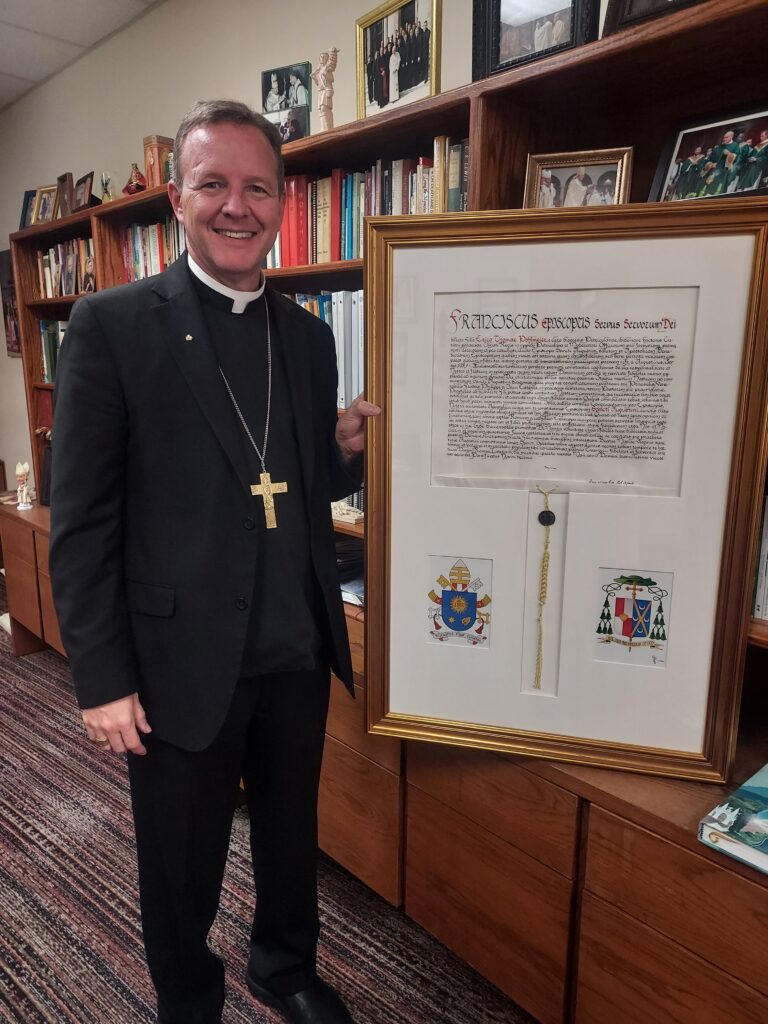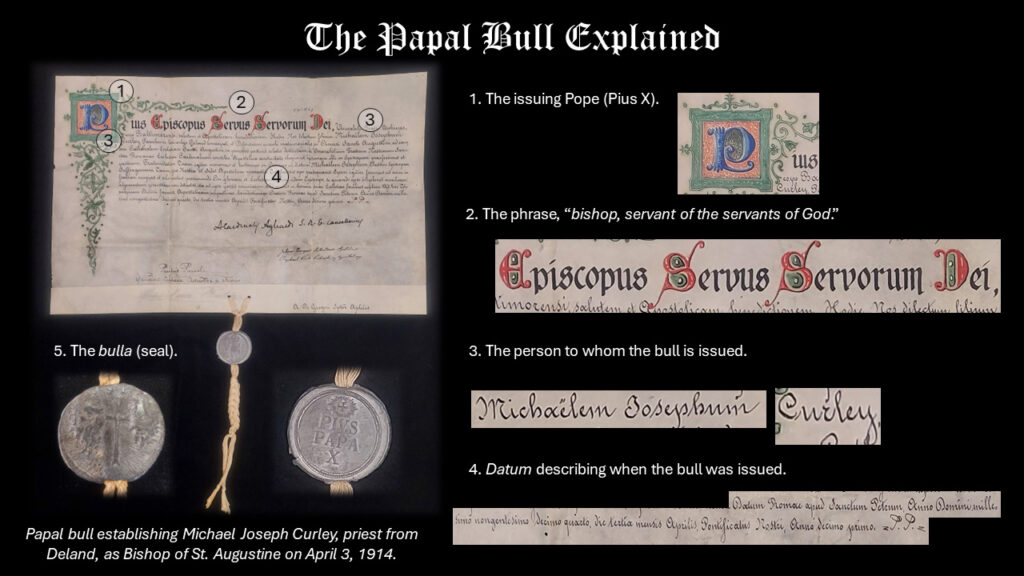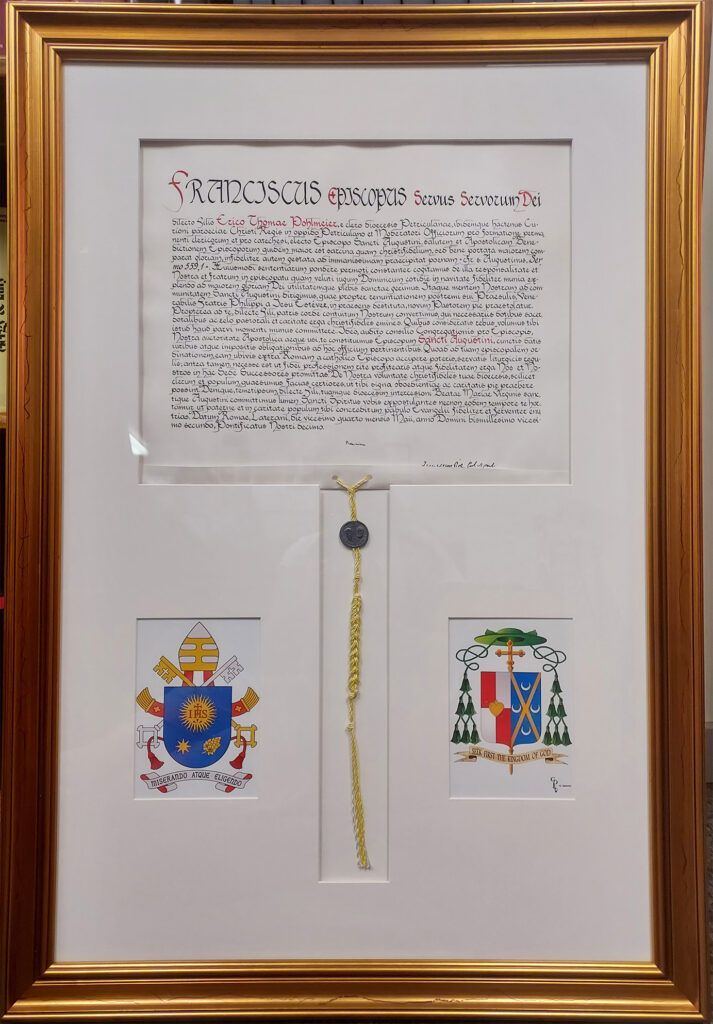On May 24, 2022, I woke up to discover that St. Augustine had a new bishop! Watching the press conference I listened, curious about directions he planned to lead the Diocese. It was during his ordination mass when Bishop Pohlmeier proudly displaying his Papal Bull, that my interest shifted from personal to professional. Papal bulls are probably the most mistreated documents received by Diocesan Archivists.

Somewhere, in some corner of every Diocesan Archives there lurks a stack of bulls. What is a bull? It’s a formal document issued by the Pope (or his delegate) making a pronouncement (like appointing a new bishop) or, responding to a particular line of legal inquiry or petition. Each document is authenticated with a circular metal or wax seal strung to the bottom. This seal became known in Italian as a bulla, for its bubble like-shape. The nickname was probably a reference to the Latin word bullire, meaning “to bubble” or “to boil”. Correspondence from the Pope to the Faithful stretches back to the Early Church. Once the Pope’s chancellery was established (under the reign of Pope Adrian I, 772-795), notaries were employed, a scrinium (special cabinet) or archivium sanctae Romanae ecclesiae (archives of the Church) was organized, and correspondence, rescript (answers to legal inquiry or petitions), decrees, and doctrine became routinely issued. By the 15th century, the term “bull” only applied to formal documents.

Papal Bull are really easy to identify. Besides the fact that they are about three times the size of our standard 8.5” x 11” paper (the average bull is about 24” x 30”, though we have some that are larger), they are written on parchment, specially prepared untanned skin of a sheep, calf, or goat. Originally drafted on papyrus, the Pope and his scribes switched to the more durable parchment around the 11th century. I’ve read that the Vatican Archives still has a few very fragile papyrus bulls in their collections predating the 11th century, and lead seals dating back to the 6th century! The rescript (or written portion of the bull) always include the pope’s name written at the top, LARGE for all to see, following by the phrase, episcopus, servus servorum Dei, “Servant of the Servants of God.” If the pronouncement references a particular person or location, that is included in the text, often emphasized with a different color (like red). The document ends with datum, recording the time and place where the declaration was made. The rescript is authenticated using a seal. By the 18th century, lead bulla were replaced with a red ink stamp of Sts. Peter and Paul or St. Peter the Fisherman encircled by the reigning pope’s name. While red ink stamps are more common today, the Vatican still uses lead seals for special bulls, such as the one Bishop Pohlmeier displayed during his ordination.
So, we have a very important document made from animal skin, with a heavy lead seal attached on string to a hole its bottom, that is rolled into a tube and sent through the mail to the Bishop. And we have a bishop who (rightly so) wants to frame it for all to see. Unfortunately, this is where things go a little sideways. I have seen well-meaning staff, eager to help their new bishop, take his bull to a local framer who has no conservation skills or knowledge of how to handle parchment, and cause major conservation issues that damage the document over time. Let me give you some examples. I’ve received rescript framed missing the lead bulla, which destroys its authenticity. I’ve received framed rescript with a lead bulla dangling through a hole cut in the frame, its weight tearing the parchment. I have received bulls which have been spray glued to a backing that acidified over time, and trimmed edges to make it fit into a standard size frame. This last example is the most common mistreatment I’ve observed, as I’m sure frame shop staff were just trying to figure out a way to keep the bull flat.
So, what is to be done? In the case of historic bulls stacked in the Archives’ corner that have been poorly treated, we do our best to practice the first rule of preservation: do no harm. We insert store bulls in acid-free, lignin-free folders until we have the money for a professional conservator to flatten and suspend or reserve damage. If we can de-frame the item safely, we will. If we can’t, it gets stored on the shelf, as is. Recently I came across a bull that was shellacked to a decorative piece of wood and missing its seal. In my shock, I reached out to our conservators. While known to work wonders, they determined that there is no way to undo the shellac without damaging the original document. In this case, we both agreed to let sleeping bulls lie.

The best solution to long term preservation of anything is always preventative care. Our previously mentioned conservators offer preservation framing services. Since parchment is animal skin, it expands and contracts like our own skin. To mitigate damage as it swells and shrinks, the parchment is suspended between two acid-free, lignin-free mats using special short strings that move with the skin. The strings are attached with an archival paste that is gentle and removable. The place where the lead bulla is attached was reinforced and supported with an inset. The frame is sealed to keep the temperature and humidity as steady as possible and includes UV filtering glass (to avoid fading). I also requested rubber bumpers for the wall-side of the frame to remove direct contact between the wall and sealed case. This is to prevent any temperature fluctuations on an internal wall with an exterior side from affecting the bull.
Our conservators, as always, did a wonderful job framing and preserving Bishop Pohlmeier’s bull. So, the next time you pay him a visit, check out the framed bull hanging in his office.
